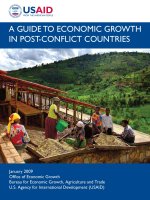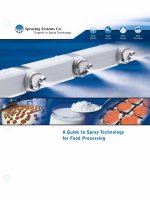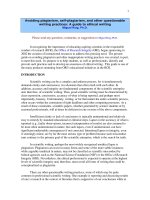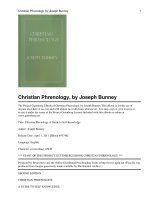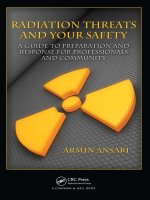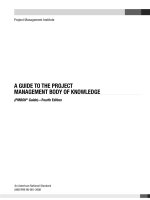Operations & Maintenance Best Practices - A Guide to Achieving Operational Efficiency docx
Bạn đang xem bản rút gọn của tài liệu. Xem và tải ngay bản đầy đủ của tài liệu tại đây (7.02 MB, 321 trang )
FEDERAL ENERGY MANAGEMENT PROGRAM
Release 3.0
Operations & Maintenance
Best Practices
A Guide to Achieving Operational Efciency
August 2010
Release 3.0
Operations & Maintenance
Best Practices
A Guide to Achieving Operational Efciency
G. P. Sullivan
(a)
R. Pugh
A. P. Melendez
W. D. Hunt
August 2010
Prepared by
Pacic Northwest National Laboratory
for the Federal Energy Management Program
U.S. Department of Energy
(a)
Efciency Solutions, LLC
Disclaimer
This report was sponsored by the United States Department of Energy, Office of Energy Efficiency and
Renewable Energy, Federal Energy Management Program. Neither the United States Government nor any
agency or contractor thereof, nor any of their employees, makes any warranty, express or implied, or assumes
any legal liability or responsibility for the accuracy, completeness, or usefulness of any information, apparatus,
product, or process disclosed, or represents that its use would not infringe privately owned rights. Reference
herein to any specific commercial product, process, or service by trade name, mark, manufacturer, or
otherwise, does not necessarily constitute or imply its endorsement, recommendation, or favoring by the United
States Government or any agency or contractor thereof. The views and opinions of authors expressed herein
do not necessarily state or reflect those of the United States Government or any agency or contractor thereof.
Preface
This Operations and Maintenance (O&M) Best Practices Guide was developed under the
direction of the U.S. Department of Energy’s Federal Energy Management Program (FEMP).
The mission of FEMP is to facilitate the Federal Government’s implementation of sound, cost-
effective energy management and investment practices to enhance the nation’s energy security and
environmental stewardship. Each of these activities is directly related to achieving requirements set
forth in:
• The Energy Policy Act of 2005, which established a number of energy and water management
goals for Federal facilities and eets and also amended portions of the National Energy
Conservation Policy Act (NECPA).
• Executive Order 13423, Strengthening Federal Environmental, Energy, and Transportation
Management (signed in January 2007). This set more challenging goals than EPAct 2005 and
superseded existing executive orders 13123 and 13149.
• The Energy Independence and Security Act of 2007, which further established energy, water, and
building commissioning management goals and requirements and also amended portions of
EPAct 2005 and NECPA. EISA was signed into law in December 2007.
• Executive Order 13514, Federal Leadership in Environmental, Energy and Economic Performance
(signed in October of 2009) directs Federal agencies to further address energy, water, and
operational efciency beyond E.O. 13423 with targeted goals and actions.
Release 3.0 of this guide provides updates to Release 2.0 in the areas of O&M technologies,
equipment performance, and costs. This new release also addresses water use and the impacts that
recommended O&M practices can have on water efciency.
Overall, this guide highlights O&M programs targeting energy and water efciency that are
estimated to save 5% to 20% on energy bills without a signicant capital investment. Depending
on the Federal site, these savings can represent thousands to hundreds-of-thousands dollars each
year, and many can be achieved with minimal cash outlays. In addition to energy/resource savings, a
well-run O&M program will:
• Increase the safety of all staff, as properly maintained equipment is safer equipment.
• Ensure the comfort, health, and safety of building occupants through properly functioning
equipment providing a healthy indoor environment.
• Conrm the design life expectancy of equipment is achieved.
• Facilitate the compliance with the above-mentioned Acts and Orders as well as Federal
legislation such as the Clean Air Act and the Clean Water Act, as well as expected carbon
mitigation legislation.
The focus of this guide is to provide the Federal O&M/Energy manager and practitioner with
information and actions aimed at achieving these savings and benets.
O&M Best Practices Guide, Release 3.0 iii
Acknowledgments
This report is the result of numerous people working to achieve a common goal of improving
operations and maintenance and energy/water efciency across the Federal sector. The authors
wish to acknowledge the contribution and valuable assistance provided by the staff of the Federal
Energy Management Program (FEMP). Specically, we would like to thank Ab Ream and Shawn
Herrera, FEMP Program Managers, for their leadership and support of the FEMP Operations and
Maintenance program.
In addition, the authors would like to recognize Bill Sandusky of the Pacic Northwest National
Laboratory (PNNL) for his continued commitment and recognition of the resource savings
potential of O&M to the Federal sector. Also from PNNL, Eric Richman and Carol Jones, and
Hayden McKay of Hayden McKay Lighting Design, Inc. for their work on the Lighting section of
this document.
Beth Shearer, of Beth Shearer and Associates, provided a conscientious review of material
provided in this version of the document. She provided invaluable comments and suggestions to
improve the quality of the document.
Finally, the authors would like to extend their appreciation to PNNL’s document production
team – Dave Payson and Elaine Schneider – for the conscientious, team-oriented, and high quality
assistance they brought to this version of the document.
O&M Best Practices Guide, Release 3.0 v
Contents
Preface iii
Acknowledgments v
Chapter 1 Introduction and Overview 1.1
1.1 About This Guide 1.1
1.2 Target Audience 1.2
1.3 Organization and Maintenance of the Document 1.2
Chapter 2 Why O&M? 2.1
2.1 Introduction 2.1
2.2 Denitions 2.1
2.3 Motivation 2.1
2.4 O&M Potential, Energy Savings, and Beyond 2.3
2.5 References 2.6
Chapter 3 O&M Management 3.1
3.1 Introduction 3.1
3.2 Developing the Structure 3.1
3.3 Obtain Management Support 3.3
3.3.1 The O&M Mission Statement 3.3
3.4 Measuring the Quality of Your O&M Program 3.4
3.5 Selling O&M to Management 3.5
3.6 Program Implementation 3.6
3.7 Program Persistence 3.6
3.8 O&M Contracting 3.6
3.8.1 O&M Contract Types 3.8
3.8.2 Contract Incentives 3.9
3.9 O&M: The ESPC Perspective 3.12
3.9.1 O&M Needs for Veried and Persistent Savings 3.12
3.9.2 Determination and Verication of O&M Savings in ESPCs 3.14
3.10 References 3.15
Chapter 4 Computerized Maintenance Management System 4.1
4.1 Introduction 4.1
4.2 CMMS Needs Assessment 4.1
4.3 CMMS Capabilities 4.1
4.4 CMMS Benets 4.3
4.5 CMMS Resources 4.3
4.6 Reference 4.3
O&M Best Practices Guide, Release 3.0 vii
Contents
Chapter 5 Types of Maintenance Programs 5.1
5.1 Introduction 5.1
5.2 Reactive Maintenance 5.2
5.3 Preventive Maintenance 5.3
5.4 Predictive Maintenance 5.4
5.5 Reliability Centered Maintenance 5.5
5.6 How to Initiate Reliability Centered Maintenance 5.6
5.7 References 5.9
Chapter 6 Predictive Maintenance Technologies 6.1
6.1 Introduction 6.1
6.2 Thermography 6.2
6.2.1Introduction 6.2
6.2.2Types of Equipment 6.2
6.2.3System Applications 6.4
6.2.3.1 Electrical System Applications 6.4
6.2.3.2 Mechanical System Applications 6.5
6.2.3.3 Roof Thermography 6.8
6.2.4Equipment Cost/Payback 6.8
6.2.5Training Availability 6.9
6.2.6Case Studies 6.9
6.2.7Resources 6.10
6.2.7.1 Infrared Service Companies 6.11
6.2.7.2 Infrared Internet Resource Sites 6.11
6.3 Lubricant and Wear Particle Analysis 6.12
6.3.1Introduction 6.12
6.3.2Test Types 6.13
6.3.3Types of Equipment 6.15
6.3.4System Applications 6.15
6.3.5Equipment Cost/Payback 6.16
6.3.6Training Availability 6.16
6.3.7Case Studies 6.16
6.3.8References/Resources 6.17
6.3.8.1 Analysis Equipment Resources 6.17
6.3.8.2 Oil Analysis Laboratories 6.17
6.3.8.3 Internet Resource Sites 6.18
6.4 Ultrasonic Analysis 6.19
6.4.1Introduction 6.19
6.4.2Types of Equipment 6.20
6.4.3System Applications 6.21
6.4.3.1 Pressure/Vacuum Leaks 6.21
6.4.3.2 Mechanical Applications 6.21
6.4.3.3 Electrical Applications 6.22
6.4.4Equipment Cost/Payback 6.22
6.4.5Training Availability 6.22
6.4.6Case Studies 6.23
6.4.7References/Resources 6.23
O&M Best Practices Guide, Release 3.0 viii
Contents
6.4.7.1 Equipment Resources 6.23
6.4.7.2 Service Companies 6.24
6.4.7.3 Internet Resource Sites 6.24
6.5 Vibration Analysis 6.25
6.5.1Introduction 6.25
6.5.2Types of Equipment 6.26
6.5.3System Applications 6.27
6.5.4Equipment Cost/Payback 6.28
6.5.5Training Availability 6.28
6.5.6Case Studies 6.28
6.5.7References/Resources 6.28
6.5.7.1 Training Equipment Resources 6.29
6.5.7.2 Service Companies 6.29
6.5.7.3 Training/Internet Resource Sites 6.29
6.6 Motor Analysis 6.30
6.6.1Introduction 6.30
6.6.2Motor Analysis Test 6.30
6.6.2.1 Electrical Surge Comparison 6.30
6.6.2.2 Motor Current Signature Analysis 6.30
6.6.3System Applications 6.31
6.6.4Equipment Cost/Payback 6.31
6.6.5Training Availability 6.31
6.6.6References/Resources 6.32
6.6.6.1 Equipment Resources 6.32
6.6.6.2 Service Companies 6.32
6.6.6.3 Internet Site Resources 6.32
6.7 Performance Trending 6.33
6.7.1Introduction 6.33
6.7.2How to Establish a Performance Trending Program 6.33
6.7.3System Applications 6.34
6.7.4Equipment Cost/Payback 6.34
6.7.5Training Availability 6.34
6.7.6Case Studies 6.35
6.8 References 6.35
Chapter 7 Commissioning Existing Buildings 7.1
7.1 Introduction 7.1
7.2 Denitions 7.2
7.3 Typical Findings from Existing Building Commissioning 7.4
7.5 Tracking Commissioning Benets 7.6
7.6 The Commissioning Process 7.7
7.7 Commissioning Provider Qualications 7.8
7.8 The Future of Building Commissioning 7.8
7.9 Case Studies 7.9
7.9.1System Shutdown During Unoccupied Periods 7.9
7.9.2In-House Recommissioning at a DOE National Laboratory 7.10
O&M Best Practices Guide, Release 3.0 ix
Contents
7.10 Additional Resources 7.12
7.11 References 7.12
Chapter 8 Metering for Operations and Maintenance 8.1
8.1 Introduction 8.1
8.2 Importance of Metering and the Business Case 8.2
8.3 Metering Applications 8.3
8.4 Metering Approaches 8.4
8.4.1One-Time/Spot Measurements 8.4
8.4.2Run-Time Measurements 8.5
8.4.3Short-Term Measurements/Monitoring 8.5
8.4.4Long-Term Measurements/Monitoring 8.6
8.4.5The Metering Hierarchy 8.6
8.5 Metering System Components 8.7
8.5.1Meters 8.7
8.5.2Data Collection 8.8
8.5.3Data Storage 8.8
8.5.4Data Analysis 8.9
8.6 Metering Economics 8.9
8.7 Metering Financing Options 8.11
8.7.1Metering Financing Hierarchy 8.11
8.8 Steps in Meter Planning 8.13
8.8.1Establish Program Goals and Objectives 8.13
8.8.2Identify Needs to Support Selected Analysis Approaches 8.13
8.8.3Develop and Apply Evaluation Criteria 8.14
8.8.4Implementation, Design, and Installation 8.15
8.8.5Performance Validation and Persistence 8.15
8.9 Case Study – General Services Administration’s Kastenmeier Federal Courthouse 8.15
8.10 References 8.18
Chapter 9 O&M Ideas for Major Equipment Types 9.1
9.1 Introduction 9.1
9.1.1Lock and Tag 9.1
9.2 Boilers 9.3
9.2.1 Introduction 9.3
9.2.2.1 Fire-Tube Boilers 9.3
9.2.2.2 Water-Tube Boilers 9.3
9.2.2.3 Electric Boilers 9.4
9.2.3 Key Components 9.5
9.2.3.1 Critical Components 9.5
9.2.3.2 Other Components 9.7
9.2.4 Safety Issues 9.8
9.2.5.1 Efciency, Safety, and Life of the Equipment 9.9
9.2.5.2 Boiler Energy Best Practices 9.9
9.2.5Cost and Energy/Water Efciency 9.9
9.2.5.1 Efciency, Safety, and Life of the Equipment 9.9
9.2.5.2 Boiler Energy Best Practices 9.9
O&M Best Practices Guide, Release 3.0 x
Contents
9.2.6Maintenance of Boilers 9.12
Tools 9.12 9.2.7Diagnostic
9.2.8Available Software Tools 9.13
9.2.9Relevant Operational/Energy Efciency Measures 9.14
9.2.9.1 Boiler Measure #1: Boiler Loading, Sequencing, Scheduling, and Control 9.14
9.2.9.2 Boiler Measure #2: Boiler Combustion Efciency 9.17
9.2.9.3 Boiler Measure #3: Trending Boiler Stack Temperature 9.20
9.2.9.4 Opportunity Identication 9.20
9.2.10 Boiler Rules of Thumb 9.24
9.2.10.1 Boiler Water-Use Best Practices 9.25
9.2.11 Case Studies 9.26
9.2.12 Boiler Checklist, Sample Boiler Maintenance Log, and WaterQuality Test 9.26
9.2.13 References 9.32
9.3 Steam Traps 9.34
9.3.1Introduction 9.34
9.3.2Types of Steam Traps 9.34
9.3.2.1 Mechanical Steam Trap 9.34
9.3.2.2 Thermostatic Steam Trap 9.35
9.3.2.3 Thermodynamic Steam Traps 9.36
9.3.2.4 Other Steam Traps 9.37
9.3.3Safety Issues 9.37
9.3.4.1 Other Costs 9.37
9.3.4Cost and Energy Efciency 9.37
9.3.5Maintenance of Steam Traps 9.39
9.3.5.1 Characteristics of Steam Trap Failure 9.39
9.3.6Performance Assessment 9.41
9.3.7Diagnostic Equipment 9.43
9.3.8Relevant Operational/Energy Efciency Measures 9.43
9.3.8.1 Steam Trap Water-Use Best Practices 9.45
9.3.9Case Studies 9.45
9.3.10 Steam Traps Checklist 9.47
9.3.11 References 9.47
9.4 Chillers 9.48
9.4.1Introduction 9.48
9.4.2Types of Chillers 9.48
9.4.2.1 Mechanical Compression Chiller 9.48
9.4.2.2 Absorption Chiller 9.49
9.4.3Key Components 9.49
9.4.3.1 Mechanical Compression Chillers 9.49
9.4.3.2 Absorption Chiller 9.49
Issues 9.4.4Safety
9.4.5Cost and Energy Efciency
9.4.6Maintenance of Chillers
Tools 9.52 9.4.7Diagnostic
9.4.8Available Software Tool 9.52
9.4.9Relevant Operational/Energy Efciency Measures 9.53
9.4.9.1 Chiller Water-Use Best Practices 9.57
9.4.10 Chillers Checklist 9.57
9.4.11 Sample Chiller Operation Log 9.59
O&M Best Practices Guide, Release 3.0 xi
Contents
9.4.12 References 9.60
9.5 Cooling Towers 9.61
9.5.1Introduction 9.61
9.5.2 Types of Cooling Towers 9.61
9.5.3 Key Components 9.62
9.5.4 Safety Issues 9.62
9.5.5 Cost and Energy Efciency 9.63
9.5.6 Maintenance of Cooling Towers 9.63
9.5.7 Common Causes of Cooling Towers Poor Performance 9.64
9.5.8 Diagnostic Tools 9.64
9.5.8.1 Cooling Tower Water-Use Best Practices 9.64
9.5.8.2 Operations and Maintenance Opportunities 9.66
9.5.8.3 Retrot Opportunities 9.67
9.5.9 Cooling Towers Checklist 9.68
9.5.10 References 9.69
9.6 Energy Management/Building Automation Systems 9.70
9.6.1 Introduction 9.70
9.6.2 System Types 9.70
9.6.3 Key Components 9.71
9.6.4 Safety Issues 9.71
9.6.5 Cost and Efciency 9.71
9.6.6 Maintenance 9.71
9.6.7 Diagnostic Equipment 9.72
9.6.8 Relevant Operational/Energy Efciency Measures 9.72
9.6.9 Case Studies 9.77
9.6.10 Building Controls Checklist 9.80
9.6.11 References 9.81
9.7 Air Handling Systems 9.82
9.7.1 Introduction 9.82
9.7.2 Types of Air Handling Systems 9.82
9.7.3 Key Components 9.82
9.7.4 Cost and Energy Efciency 9.82
9.7.5 Maintenance 9.83
9.7.5.1 Diagnostic Tools 9.83
9.7.5.2 Case Study 9.83
9.7.6 Air Handling System Checklists 9.84
9.7.7 References 9.86
9.8 Fans 9.87
9.8.1 Introduction 9.87
9.8.2 Types of Fans
9.8.2.1 Axial Fan 9.87
9.8.2.2 Centrifugal Fans 9.88
9.8.3 Key Components 9.89
9.8.4 Safety Issues 9.89
9.8.5 Cost and Energy Efciency 9.89
9.8.6 Maintenance of Fans 9.89
9.8.7 Diagnostic Tools 9.90
9.8.8 Available Software Tools 9.90
O&M Best Practices Guide, Release 3.0 xii
Contents
9.8.9 Relevant Operational/Energy Efciency Measures 9.91
9.8.10 Case Studies 9.93
9.8.11 Fans Checklist 9.94
9.8.12 References 9.95
9.9 Pumps 9.96
9.9.1 Introduction 9.96
9.9.2 Types of Pumps 9.97
9.9.2.1 Dynamic Pump (Centrifugal Pump)
9.9.2.2 Positive Displacement Pump
9.9.3 Key Components 98
9.9.3.1 Centrifugal Pump
9.9.3.2 Positive Displacement Pumps 98
9.9.4Safety Issues
9.9.5Cost and Energy Efciency 100
9.9.6Maintenance of Pumps
9.9.7Diagnostic Tools 101
9.9.8Available Software Tools 102
9.9.9Relevant Operational/Energy Efciency Measures 102
9.9.9.1Pump System Water-Use Best Practices 105
9.9.10 Case Study
9.9.11 Pumps Checklist 107
9.9.12 References 108
9.10 Motors 109
9.10.1 Introduction 109
9.10.2 Types of Motors 109
9.10.2.1 DC Motors 109
9.10.2.2 AC Motors
9.10.3 Key Components 110
9.10.3.1 DC Motor
9.10.3.2 AC Motor 111
9.10.4 Safety Issues
9.10.5 Cost and Energy Efciency
9.10.6 Maintenance of Motors 113
9.10.7 Diagnostic Equipment 114
9.10.8 Available Software Tools 114
9.10.9 Relevant Operational/Energy Efcient Measures 115
9.10.10 Electric Motors Checklist 118
9.10.11 References 119
9.11 Air Compressors 120
9.11.1 Introduction 120
9.11.2 Types of Air Compressors
9.11.2.1 Positive Displacement 120
9.11.2.2 Centrifugal Compressor 121
9.11.3 Key Components
9.11.4 Safety Issues
9.11.4.1 General Safety Requirements for Compressed Air 122
9.11.5 Cost and Energy Efciency
9.11.5.1 Identify the Electrical Cost of Compressed Air 123
O&M Best Practices Guide, Release 3.0 xiii
Contents
9.11.5.2 Waste Heat Recovered from Compressors can be Used for Heating
9.11.5.3 Use of Flow Controllers 125
9.11.5.4 Importance of Maintenance to Energy Savings 125
9.11.5.5 Leak Evaluation Procedure 9.125
9.11.6 Maintenance of Air Compressors
9.11.6.1 General Requirements for a Safe and Efcient Air Compressor 9.126
9.11.7 Diagnostic Tools 9.128
9.11.8 Available Software Tools 9.128
9.11.9 Relevant Operational/Energy Efciency Measures 9.129
9.11.9.1 Air Compressor Water-Use Best Practices 129
9.11.10 Case Study 131
9.11.11 Air Compressors Checklist 132
9.11.12 References 133
9.12 Lighting 135
9.12.1 Introduction 135
9.12.2 Systems and Components 135
9.12.2.1 Light Sources 135
9.12.2.2 Ballasts, Transformers, and Power Packs 138
9.12.2.3 Luminaire Housing 139
9.12.2.4 Lighting Control Devices 140
9.12.3 Safety Issues 146
9.12.3.1 Electrical and Equipment Safety 146
9.12.3.2 Hazardous Materials Handling 147
9.12.4 Energy Efciency, Savings, and Cost 148
9.12.4.1 Planned versus Reactive Maintenance 148
9.12.4.2 Response to Complaints 150
9.12.4.3 Retrot versus Redesign 150
9.12.4.4 Energy Codes 153
9.12.5 Maintenance Procedures 153
9.12.5.1 Commissioning 153
9.12.5.2 Common Causes of Poor Performance 154
9.12.5.3 Cleaning 154
9.12.5.4 Lamp and Ballast Troubleshooting 55
9.12.5.5 Lighting Controls Calibration and Troubleshooting 156
9.12.5.6 Diagnostic Tools 157
9.12.5.7 Economics 159
9.12.6 Lighting Checklist 160
9.12.7 References 161
Chapter 10 O&M Frontiers 10.1
10.1 ACRx Handtool/Honeywell HVAC Service Assistant 10.1
10.2 Decision Support for O&M 10.2
10.3 ENFORMA
®
Portable Diagnostic Solutions 10.2
10.4 Performance and Continuous Re-Commissioning Analysis Tool 10.3
10.5 Energy Expert 10.4
10.6 Reference 10.4
Chapter 11 Ten Steps to Operational Efciency 11.1
O&M Best Practices Guide, Release 3.0 xiv
Contents
Appendix A – Glossary of Common Terms A.1
Appendix B – FEMP Contact List B.1
Appendix C – Resources for Energy and Facilities Professionals C.1
Appendix D – Suggestions for Additions or Revisions D.1
Figures
2.4.1 Effect of adequate and timely maintenance and repairs on the service life 2.5
5.1.1 Component failure rate over time for component population 5.1
6.2.1 Typical IR spot thermometer 6.2
6.2.3 Temperature is used in dening belt problems 6.3
6.2.2 Internal house wall 6.4
6.2.4 Air breaker problem 6.5
6.2.5 Overloaded contacts show different temperature proles indicating one contact
seeing much greater load, a potentially unsafe situation. 6.5
6.2.6 IR scans of multiple electric motors can highlight those with hot bearings indicting
an imbalance or wear problem 6.6
6.2.7 Possible gearbox problem indicated by white area dened by arrow 6.6
6.2.8 Seized conveyer belt roller as indicated by elevated temperatures in belt/roller 6.6
6.2.9 Inoperable steam heaters seen by cooler blue areas when compared to the operating
heaters warmer red or orange colors. 6.6
6.2.11 When trended, IR scans of single bearings provide a useful indicator of wear and
eventual need for replacement 6.7
6.2.10 IR scans of boiler can highlight those areas where the refractory has broken down
leading to costly heat loss 6.7
6.2.12 Steam or hot water distribution system leaks and/or underground line location can
be dened with IR 6.7
6.5.1 Vibration severity chart 6.25
6.5.2 FFT – Example of graph breaking down vibration level at different frequencies 6.26
6.5.3 Typical vibration transducers 6.26
6.7.1 Boiler Cycling Frequency Data 6.37
7.4.1 Construction Phase CX costs 7.5
7.9.1 Whole-building electricity use before and after night shutdown program 7.10
7.9.2 PNNL EMSL building energy performance by scal year 7.11
8.1.1 Typical utility socket-type meter 8.1
8.4.1 Electric metering hierarchy 8.7
8.5.1 Typical electrical sub panel used in long-term monitoring 8.8
8.7.1 The metering nancing hierarchy 8.12
8.8.1 Development process for meter system planning 8.14
O&M Best Practices Guide, Release 3.0 xv
Contents
8.9.1 Installed wireless monitoring system for WBE-based system 8.17
8.9.2 Sample screen capture for a generic building showing an alarm or high-energy
using condition 8.18
8.9.3 Data from the monitoring device provides a comparison of 2 days of electricity 8.18
9.1.1 Typical folding lock and tag scissor clamp 9.2
9.2.1 Horizontal return re-tube boiler 9.3
9.2.3 Electric boiler 9.4
9.2.2 Longitudinal-drum water-tube boiler 9.4
9.2.4 Adapted from 1999 National Board of Boiler and Pressure Vessel Inspectors
incident report summary. 9.8
9.2.5 Effect of fouling on water side 9.9
9.2.6 Combustion analyzer 9.18
9.2.7 Example locations – combustion analysis 9.18
9.2.8 Boiler tube – scale deposit 9.21
9.2.9 Boiler tube – failure (rupture) 9.21
9.2.10 Feed-water pipe – oxygen pitting 9.22
9.2.12 Condensate pipe – oxygen pitting 9.22
9.2.14 Boiler energy losses versus scale thickness 9.22
9.2.11 Boiler tube – failure (rupture) 9.22
9.2.13 Condensate pipe – acidic corrosion 9.22
9.3.1 Inverted bucket steam trap 9.34
9.3.2 Bimetallic steam trap 9.35
9.3.3 Bellows steam trap 9.35
9.3.5 Disc steam trap 9.36
9.3.4 Float and thermostatic steam trap 9.36
9.3.6 Energy loss from leaking steam traps 9.38
9.3.7 Live steam (left) versus ash steam (right) 9.41
9.3.8 Failed gasket on blind ange 9.45
9.4.1 Typical chiller plant 9.48
9.5.2 Direct or open cooling tower 9.61
9.5.1 Cooling tower 9.61
9.6.1 General Services Administration’s Custom House, Philadelphia, PA 9.77
9.7.1 Cooling coil requiring cleaning 9.84
9.7.2 Damper quick x – not recommended 9.84
9.8.1 Propeller direct-drive fan (front and rear view). 9.84
9.8.2 Propeller belt-drive fan (front and rear view). 9.87
9.8.3 Tube-axial fan 9.87
9.8.4 Vane axial fan 9.88
9.8.5 Centrifugal fan 9.88
9.9.1 Technology tree for pumps 9.88
9.9.2 Rotary lobe pump 9.96
9.9.3 Positive displacement pumps. 9.97
9.9.4 Centrifugal pump. 9.98
9.9.5 Schematic of pump and relief valve 9.99
9.9.7 Retrot cost savings ($5,800 annually). 9.106
9.9.6 Pump system energy use and savings 9.106
O&M Best Practices Guide, Release 3.0 xvi
Contents
9.10.1 DC motor 9.109
9.10.2 AC motor 9.110
9.10.3 Parts of a direct current motor 9.111
9.10.4 Parts of an alternating current motor 9.111
9.11.1 Rotary screw compressor 9.120
9.11.2. Typical single acting two-stage compressor 9.121
9.11.3 Helical-lobe rotors 9.122
9.12.1 Fluorescent lamp/ballast efcacy 9.138
9.12.2 Wall-box occupancy sensor uses hidden internal dip-switches to set manual-on,
auto-off. 9.141
9.12.3 Photosensor and uorescent dimming ballast for continuous daylight dimming 9.145
9.12.4 Repair and rewiring must be done by a licensed electrician. 9.146
9.12.5 Fluorescent lamp mortality curve 9.149
9.12.6 Lighting uniformity and xture spacing criteria 9.151
9.12.8 Calibrations for controls 9.156
9.12.7 Ceiling occupancy sensor 9.157
Tables
3.1.1 Industry O&M metrics and benchmarks 3.5
3.2.2 Overview of key O&M issues, timing, and supporting documents 3.13
5.5.1 Reliability centered maintenance element applications 5.6
6.1.1 Common predictive technology applications 6.1
7.1.1 Commissioning type consideration by facility condition 7.1
9.2.1 Boiler cycling energy loss 9.14
9.2.2 Optimum excess air 9.17
9.2.3 Recommended limits for boiler-water concentrations 9.21
9.3.1 Steam trap discharge rate 9.43
9.6.1 Custom House demand reduction and savings 2005-2006 9.79
9.8.1 Fan-ow control comparison 9.92
9.11.4 Steam trap discharge rate 9.129
9.11.5 Compressed air leaks – cost per year assuming $0.05/kWh 9.131
O&M Best Practices Guide, Release 3.0 xvii
Chapter 1 Introduction and Overview
The purpose of this guide is to provide you, the Operations and Maintenance (O&M)/Energy
manager and practitioner, with useful information about O&M management, technologies, energy
and water efciency, and cost-reduction approaches. To make this guide useful and to reect
your needs and concerns, the authors met with O&M and Energy managers via Federal Energy
Management Program (FEMP) workshops. In addition, the authors conducted extensive literature
searches and contacted numerous vendors and industry experts. The information and case studies
that appear in this guide resulted from these activities.
It needs to be stated at the outset that this guide is designed to provide information on effective
O&M as it applies to systems and equipment typically found at Federal facilities. This guide is not
designed to provide the reader with step-by-step procedures for performing O&M on any specic
piece of equipment. Rather, this guide rst directs the user to the manufacturer’s specications
and recommendations. In no way should the recommendations in this guide be used in place of
manufacturer’s recommendations. The recommendations in this guide are designed to supplement
those of the manufacturer, or, as is all too often the case, provide guidance for systems and equipment
for which all technical documentation has been lost.
As a rule, this guide will rst defer to the manufacturer’s recommendations on equipment
operation and maintenance.
Actions and activities recommended in this guide should
only be attempted by trained and certied personnel. If such
personnel are not available, the actions recommended here
should not be initiated.
1.1 About This Guide
This guide is designed to serve as a resource for O&M management and technical staff.
It does not try to represent the universe of O&M-related material. Rather, it attempts to:
• Provide needed background information on why O&M is important
and the potential for savings from good O&M.
• Dene the major O&M program types and provide guidance
on the structure of a good O&M program.
• Provide information on state-of-the-art maintenance
technologies and procedures for key equipment.
• Identify information sources and contacts to assist you in getting your job done.
O&M Best Practices Guide, Release 3.0 1.1
Introduction and Overview
1.2 Target Audience
O&M/Energy managers, practitioners, and technical staff represent the prime focus of this
document. However, a competent O&M program requires the participation of staff from ve well-
dened areas: Operations, Maintenance, Engineering, Training, and Administration. While a given
site may not have all ve of these areas as separate entities, these functions are provided for within
the organization. It is these staff that are targeted.
A successful O&M program requires cooperation, dedication, and participation at all levels
and cannot succeed without everyone involved understanding the basic principles and supporting
the cause.
1.3 Organization and Maintenance of the Document
It is the intention of the authors to update this guide periodically as new O&M procedures and
technologies are developed and employed. This guide can be found on the FEMP Web site at
The guide consists of eleven chapters. This chapter provides an introduction and an overview.
Chapter 2 provides the rationale for “Why O&M?” Chapter 3 discusses O&M management issues
and their importance. Chapter 4 examines Computerized Maintenance Management Systems
(CMMS) and their role in an effective O&M program. Chapter 5 looks at the different types of
maintenance programs and denitions. Chapter 6 focuses on maintenance technologies, particularly
the most accepted predictive technologies. Chapter 7 describes the building commissioning process
and how it contributes to effective O&M. Chapter 8 covers the topic of metering and its applications
for improved operations and efciency. Chapter 9 explores O&M procedures for the predominant
equipment found at most Federal facilities and, where applicable, provides calculation procedures for
estimating energy savings. Chapter 10 describes some of the promising O&M technologies and tools
on the horizon to increase O&M efciency. Chapter 11 provides ten steps to initiating an operational
efciency program.
The O&M environment is in a constant state of evolution and the technologies and vocabularies
are ever expanding. Therefore, a glossary of terms is presented in Appendix A. Appendix B provides
a list of Federal contacts for training and assistance. Appendix C includes a list of organizations and
trade groups that have interest or are related to O&M. And nally, Appendix D is a form that can be
used to submit suggestions or revisions to this guide.
Again, we designed this to be a useful document, and we welcome your input to help us keep it
current. Please feel comfortable to make suggestions for changes, additions, or deletions using the
form found in Appendix D.
O&M Best Practices Guide, Release 3.0 1.2
Chapter 2 Why O&M?
2.1 Introduction
Effective O&M is one of the most cost-effective methods for ensuring reliability, safety, and
energy efciency. Inadequate maintenance of energy-using systems is a major cause of energy waste in
both the Federal Government and the private sector. Energy losses from steam, water and air leaks,
uninsulated lines, maladjusted or inoperable controls, and other losses from poor maintenance are
often considerable. Good maintenance practices can generate substantial energy savings and should
be considered a resource. Moreover, improvements to facility maintenance programs can often be
accomplished immediately and at a relatively low cost.
2.2 Denitions
Operations and Maintenance are the decisions and actions regarding the control and upkeep of
property and equipment. These are inclusive, but not limited to, the following: 1) actions focused on
scheduling, procedures, and work/systems control and optimization; and 2) performance of routine,
preventive, predictive, scheduled and unscheduled actions aimed at preventing equipment failure or
decline with the goal of increasing efciency, reliability, and safety.
Operational Efciency represents the life-cycle, cost-effective mix of preventive, predictive, and
reliability-centered maintenance technologies, coupled with equipment calibration, tracking, and
computerized maintenance management capabilities all targeting reliability, safety, occupant comfort,
and system efciency.
2.3 Motivation
In October of 2009, EO 13514 was signed into law. This order directs Federal agencies to further
address energy, water, and operational efciency beyond E.O. 13423.
The key energy- and operational-efciency-related provisions in the Executive Order are
as follows:
• Federal agencies must enhance efforts toward sustainable buildings and communities. Specic
requirements include the implementation of high-performance sustainable Federal building
design, construction, operation and management, maintenance, and deconstruction.
• Pursuing cost-effective, innovative strategies (e.g., highly reective and vegetated
roofs) to minimize consumption of energy, water, and materials.
• Managing existing building systems to reduce the consumption of energy, water, and materials,
and identifying alternatives to renovation that reduce existing asset-deferred maintenance costs.
• Reducing potable water consumption intensity 2% annually through FY
2020, or 26% by the end of FY2020, relative to a FY2007 baseline.
• Reducing agency industrial, landscaping, and agricultural water consumption 2%
annually, or 20% by the end of FY2020, relative to a FY2010 baseline.
• Identifying, promoting, and implementing water reuse strategies consistent
with state law that reduce potable water consumption.
O&M Best Practices Guide, Release 3.0 2.1
Why O&M?
While applicable only to Department of Energy facilities, DOE Order 430.2B was issued in
February 2008 clearly outlining the requirements and responsibilities for managing DOE facilities.
The relevance of this Order lies in forward-thinking and highlights DOE’s commitment to energy and
resource efciency.
The key energy- and operational-efciency-related provisions in the DOE Order are as follows:
• By FY 2015, reduce energy intensity by no less than 30% on average across the entire
Department, relative to the Department’s energy use in FY 2003. Energy intensity means energy
consumption per gross square foot of building space, including industrial and laboratory facilities.
• By FY 2015, reduce potable water use by no less than 16%, relative
to the Department’s potable water use in FY 2007.
• Install advanced electric metering systems at all Department sites in accordance with the DOE
metering plan for site monitoring of electric energy. Standard metering systems for steam, natural
gas, and water must also be installed and centrally monitored at all Department sites for steam,
natural gas, and water consumption. Advanced meters are dened as having the capability to
measure and record interval data (at least hourly for electricity) and communicate the data to
a remote location in a format that can be easily integrated into an advanced metering system.
• Use standardized operations and maintenance (O&M) and measurement and verication (M&V)
protocols coupled with real-time information collection and centralized reporting capabilities.
While effective, some feel that capital upgrades are not
always the most cost-effective solution. Indeed, the authors
of this guide contend that low-cost/no-cost O&M measures
(including activities referred to as retrocommissioning
or retuning) should be the rst energy savings measure
considered. O&M measures should be considered prior to
the installation of energy conservation measures for the
following reasons:
• Typically, O&M measures are low-cost or no-cost in nature.
• Many O&M measures are easily installed by in-house personnel.
• O&M measures can have immediate payback.
• These measures rarely require the design time, bid preparation, evaluation, and
response compared to capital projects that can take up to a year to implement.
O&M Best Practices Guide, Release 3.0 2.2
Why O&M?
Is an Energy Savings Performance Contract Being Considered?
(Haasl and Sharp 1999)
Some level of retrocommissioning (i.e., O&M best practices) is usually appropriate if you are considering any
type of energy savings agreement such as an energy savings performance contract. There are two primary
reasons for performing retrocommissioning before obtaining an energy-savings agreement. First, the low-cost
energy savings gained from retrocommissioning remains with the building (the owner gets all of the savings) and
does not become part of the financial agreement; second, retrocommissioning optimizes the existing equipment so
the most appropriate capital measures are selected and financed through the agreement.
A good reason for doing retrocommissioning as part of an energy-savings agreement is to ensure that the
performance of new equipment is not hindered because it interfaces with older equipment, components, or systems
that are malfunctioning. Even when commissioning is specified for the new equipment, it often stops short of
looking at the systems with which the new equipment interfaces or examining how it integrates with other systems
or equipment that may affect its performance. This is especially true for energy management control systems.
Because controls are an area where many difficulties and misunderstandings occur between building owners and
performance contractors, it is a good idea to specify commissioning for both the new and existing equipment that
may affect the performance of the new equipment.
When retrocommissioning is performed before the energy-savings agreement or energy savings performance
contract is finalized, it is important to inform the contractor about the retrocommissioning activities and give him or
her a copy of the final report. If the contractor is not informed and energy bills from prior years are used to help
determine the energy baseline, the baseline may be inaccurate. This may cause the cost savings upon which the
financing is based to be significantly less than expected, leading to disagreements and even legal battles.
Retrocommissioning performed up front to capture the low-cost savings may not be a wise choice if the savings
from the retrocommissioning do not remain with the building but, instead, go into a general fund. In this case, the
"low-cost/no-cost” improvements should be part of the performance contract. In this way, a portion of the savings
stays with the building as part of the financial arrangement. Integrating the retrocommissioning measures into
the energy-savings agreement is a way to capture the savings as part of the investment repayment. The amount
invested can be increased when the savings estimates are higher. Moreover, the savings gained from bundling
these measures with the capital upgrades—especially if some of the upgrades are marginally cost-effective (i.e.,
good value but with long paybacks)—help to increase the overall viability and attractiveness of the energy savings
performance contract funding.
2.4 O&M Potential, Energy Savings, and Beyond
It has been estimated that O&M programs targeting energy efciency can save 5% to 20% on
energy bills without a signicant capital investment (PECI 1999). From small to large sites, these
savings can represent thousands to hundreds-of-thousands of dollars each year, and many can be
achieved with minimal cash outlays.
The need for effective building O&M is illustrated in Figure 2.4.1, which shows how, over
time,the performance of a building (and its components) will eventually degrade in two scenarios –
one with and one without “normal” maintenance. Of interest in the gure is the prolonged service
life achieved through effective O&M. Not shown in this gure is the additional benet of reduced
building (energy) operating costs resulting from effectively maintaining mechanical and electrical
equipment (e.g., lighting; heating, ventilation, and air conditioning [HVAC]; controls; and on-site
generation).
Beyond the potential for signicant cost and energy/resource savings, an O&M program
operatingat its peak operational efciency has other important implications:
O&M Best Practices Guide, Release 3.0 2.3




